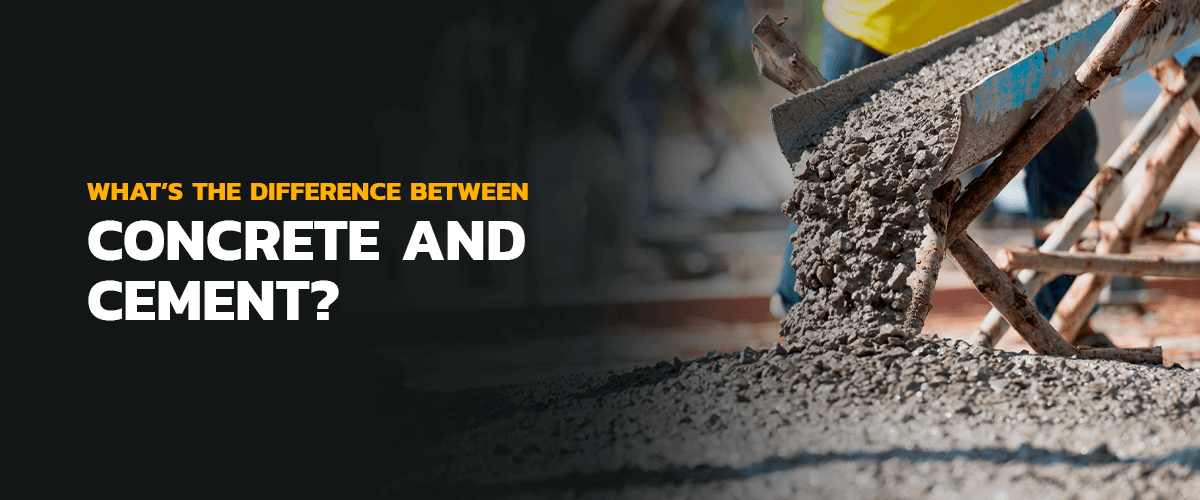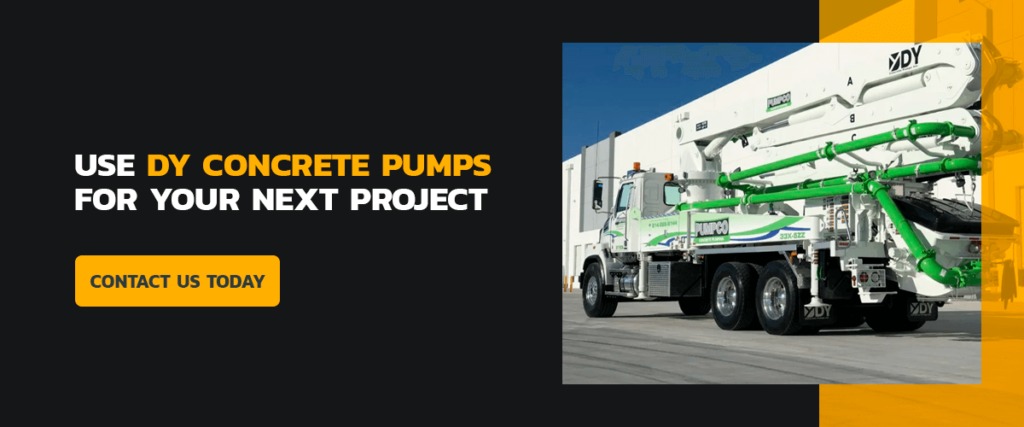What’s the Difference Between Concrete and Cement?
Posted On: 02/18/2022 | Posted by: DY Concrete Pumps

Is cement the same as concrete? You have probably heard the two terms used interchangeably and may have even done so yourself. There is a good reason for this — concrete and cement are similar, but they are not quite the same thing. Read on to learn about the concrete and cement difference, and what that means for your construction projects.
Concrete vs. Cement
The difference between cement and concrete is sort of like the difference between flour and bread. In other words, cement is the primary ingredient in concrete. Mixed with water and a few other elements, cement becomes concrete.
THE BASICS OF CONCRETE
Concrete is a mixture of water, aggregate and cement. Because these materials are so widely available, concrete is one of the most commonly used construction materials for commercial and residential projects. Concrete is a popular building substance for its plastic properties, too. That is, it’s possible to mold it into nearly any shape after mixing and before it cures. Once it cures, it continues hardening for as long as there is moisture in the concrete, which is essentially forever.
With the right blend, concrete is an extremely durable material, making it desirable for numerous uses and applications. The water and aggregate used in concrete need to be clean to avoid contaminating the concrete’s structural integrity so it will last for years. Concrete can last 30 years or more if properly taken care of.
THE BASICS OF CEMENT
Cement is a binder, which holds a mixture together for stability. Cement itself is also a blend of substances typically found in limestone, chalk, clay, shells, silica sand and other materials. To make cement, manufacturers heat these substances to a solid, then grind the result into a fine powder that can go on to form concrete.
While cement’s best-known use is the primary ingredient in concrete, mixing it with water creates grout, and combining it with water and plaster makes smooth masonry surfaces.
ARE CEMENT AND CONCRETE THE SAME FOR CONSTRUCTION PROJECTS?
One of the most notable differences between these two materials is that cement gives concrete its strength, though cement is relatively weak on its own in comparison. While concrete is significantly stronger than cement is alone, they’re essential in construction projects. However, because of their strength variations, these materials are ideal for different types of projects. Cement is suitable for smaller projects like DIY walkways, grouting and landscape edging. Concrete is best for larger projects like buildings, sidewalks, roads and numerous other structures.
HOW DOES CEMENT BECOME CONCRETE?
What is the process cement undergoes to make concrete? Though cement may be the most fundamental ingredient, it only makes up a small percentage of the total concrete mix. When mixed with water, the cement forms a paste. Combining this substance with aggregates — usually material like sand, crushed stone or gravel — creates a bond that leads to a hard, durable material through a process called hydration. The result is what we know as concrete.
HOW MUCH CEMENT IS IN CONCRETE?
The answer to this question can vary depending upon the situation, but it is critical to have the correct mix of cement and other ingredients in your concrete. If you do not have enough cement, you will lack adequate paste to fill all the spaces between the aggregates, and you will get holes within your concrete slab. If you use too much cement, you will have little trouble pouring your concrete, and you will initially get a smooth surface. However, your cement will be much more vulnerable to cracking.
The correct mixture is usually about 10 to 15% cement, 15 to 20% water and 60 to 75% aggregates. You also want to be careful about your cement-to-water ratio. More water makes the concrete easier to mix and pour, but it also leads to more shrinkage and cracking.
HOW DO YOU PLACE YOUR CONCRETE?
A cement mixer, more properly called a concrete mixer, is a device that mixes the cement with other elements so that it becomes the concrete you can then pour or pump to wherever you need it. Once you have mixed your concrete, you can pour it directly from the mixer, carry it to the desired location in wheelbarrows or use concrete pumps to deliver it. Wheelbarrows work well for small projects, though concrete pumps will help you move more concrete for bigger projects.
As you pump or pour the concrete in place, use rakes and shovels to move the wet concrete and remove air pockets. Next, you’ll use a wood or metal board to smooth and level the concrete surface so it can cure with the desired finish. As the concrete begins to firm, you can apply special finishes or stamps to create a specific look.
USE DY CONCRETE PUMPS FOR YOUR NEXT PROJECT
Designed with the user in mind, DY pumps can help you complete any concrete project with ease. With years of expertise, we have the knowledge and equipment you can rely on for increased productivity on the job site. If you need concrete pumps for your construction projects, contact DY Concrete Pumps today.


 1-844-397-8677
1-844-397-8677



